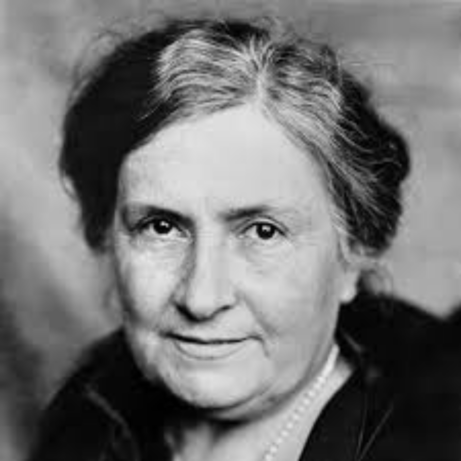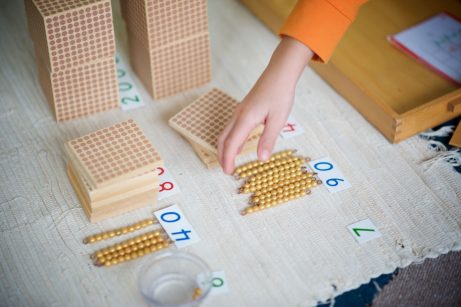Sensitive Periods

This article is the second in a series called Montessori Essentials, which aims to cover key concepts of the Montessori philosophy. These are the cornerstones of Montessori’s educational approach and concept of human development. Click the tag to explore the entire series!
The concept of sensitive periods – also sometimes referred as “critical periods” – is not unique to Montessori. In fact, the term itself originated in biology, and the concept began to arise already in the work of Édouard Séguin and Jean Marc Gaspard Itard with children with severe deprivations and resulting misdevelopment.
In short, the theory behind sensitive periods states that there are set points of human development, during which constructive formation takes place if the individual receives appropriate stimuli. If the stimuli is missing, then development is inadequate or misdirected. Later correction through therapeutic intervention may or may not be possible; however, the effort will always be greater and results lesser. For instance, a child who is born deaf will, of course, not learn to speak, unless their hearing is restored early on (such as with a cochlear implant). However timing is, well, critical: if the implant comes too late – past the critical period – spoken language will never reach the age-appropriate levels of hearing children. According to a 2007 study, the cut-off point for this is the age of two.

Explore the fundamentals of Montessori parenting with this free video by Sylvia Arotin, offering insights and strategies to empower and educate your child.
Today, critical periods are a well accepted and documented part of modern theory of human development and the concept is being popularized among parents and caregivers, especially in the context of the physical body, sensory development, and medicine. Still, Montessori education remains unique in researching and applying mental sensitive periods in service to educational and developmental aims as well, and going a step further in acknowledging the activity and agency of the child.
According to Dr. Montessori, sensitive periods apply to many facets of brain development, far more than just speech or sensory input. She identified sensitive periods, for instance, for enculturation, for role models, for fairness and justice. She did this by respecting and observing the child’s activity, for crucially, she identified a key aspect of a sensitive period: the fact that it results in directed, purposeful, focused activity.
Dr. Montessori posited, then, that it is a function of the child’s inner developmental “clock” – what, in the period of Absorbent Mind, we call “the inner teacher” – to identify the aspects of the environment that best stimulated its current developmental needs, that fulfills the requirements of the sensitive periods. Once identified, the children invests enormous amounts of effort and energy in interaction with the environment that allows them to take advantage of the stimuli. As they take what they need from, the sensitive period fades: the child has sated that particular hunger and may move on. Dr. Montessori’s definition:
Sensitive periods are an irresistible interest in an aspect of the environment, that will force the child into activity – ideally, work in the environment. Through this work they then accomplish permanent acquisition of a characteristic.
When Do The Parents Come In?
Over and over, Dr. Montessori tells us, the key role of the parent is to make way, and she often means it quite literally.
Knowledge of sensitive periods becomes an invaluable tool of any caregiver or educator, for it allows us to prepare the environment ahead of time, and make sure the child has everything they need before they even know they need it. Thus, the child will find crayons when they reach the sensitive period for scribbling and drawing (usually starting around eighteen months old, by the way) and will not have to resort to smearing their food, or worse, over the walls and tables.
This is not an exaggeration or humour, by the way. If it hasn’t been apparent from the previous text: the child badly needs to fulfill the requirements of sensitive periods to grow and develop fully. It becomes their driving force, their inescapable impulse, their very battle for survival. Very young children literally have no control over the activity dictated by a developmental sensitive period: they will prefer their activity to beloved people and possessions, even food or sleep to a degree. If hindered, they might lash out, scream, cry inconsolably.
That is the second take away all parents and caregivers would, ideally, take away from this article: how to understand and identify a child in the throes of a sensitive period. Often, we might not understand the benefit of what the child is doing. But Dr. Montessori entreats us to respect all reasonable forms of the child’s acitivity, and that goes double when that activity is meant to satisfy a sensitive period. How to tell?
- The child is focused, their attention fully on their work. Think of an infant learning to stand: her work has shrunk to the ottoman they are pulling up on, the floor she keeps bumping down to. She ignores the toys, her parents, her snack waiting on the table.
- The child has a high tolerance for failure and is exerting meaningful effort, often through many repetitions. Up, the baby pulls herself, she lets go of the ottoman, wobbles, falls back down onto her bottom. Up, she pulls herself, lets go, falls down… over and over again.
- The child reaches a point when they are done, and seem contented and refreshed rather than tired. Eventually, the baby sees her mother, and crawls over for play and kisses.
If you observe all of these characteristics, you are witnessing highly beneficial developmental activity. Observe it, enjoy it, and please let it go undisturbed if you at all can.
Sometimes, of course, you might have to disturb the child. The baby, to continue the earlier scenario, might not be pulling up on a safe ottoman, but on a wobbly bookshelf, or on the curtains. If you at all can, offer her a substitute, a safe and appropriate way to channel the same impulse – the crayons and paper over the applesauce on the wall.
Major Sensitive Periods
The first plane of development is by far the richest in sensitive periods, although they are in no way exclusive to it. This is, after all, the period of construction – the psychic embryo is creating oneself.
- Order
The child – “stranger in a strange land” – absorbs from long before birth a massive amount of information – information that she has no framework to categorize and organize. Therefore, an ordered environment is crucial, and the child will both seek out order and be heavily disturbed by the lack of it. This period peaks at about two years of age, and then gradually fades throughout the first plane of development. - Language
The sensitive period for language begins and manifests already before birth, peaks in toddlerhood and gradually fades towards the end of the second plane of development. During this time, the child needs not only language but a very special kind of it: originating from other people and directed at the child (television or radio are worse than useless). - Movement
From birth on, the child observes the movement of others around it and mimics it. Our movements – those we use unconsciously to express emotions, gesticulation, or even gait – are strongly culturally based and form a body language that the child learns and incarnates just like spoken language. This period starts shortly after birth and fades around four years of age. - Social Behavior
In adulthood, imitating social behavior may be a conscious effort, a form of respect or compliment. In the child, this imitation is quite different: a constructive effort creating new brain connections, a true assimilation. It is then obviously critical to model exactly the behavior we wish the child to incarnate – for example, the manners, politeness and courtesies that are important in our society. This period begins at the end of the symbiotic phase - Assimilation of Images
From birth on, children exhibit concentrated focus on various objects, people or situations – establishing order and creating points of reference through visual observation. This is why we advocate for clear, unobstructed field of vision for infants, and a rich variety of colourful, attractive and interesting objects to look at.
Until about six years of age, when this sensitive period fades, it is observation coupled with tactile experience that completes the mental assimilation of an image, and therefore the young child should also be provided with plentiful opportunities to touch. - Small Objects
Although not always considered a separate sensitive period, around one year of age – at the age of rapid fine motor development – children develop a special affinity for tiny details and very small objects in the environment. This period ends between three and four years of age. - Refinement of Senses
Whilst the very young child – the “unconscious creator” of the first three years of life – wanted to imitate other humans in the environment, around that age a new child is born: the “conscious worker”. This child wants to better herself and will willingly and consciously practice a task through many repetitions in order to master a skill and refine her own senses. This period begins shortly before three years of age and fades with the end of the first plane.
Later on, sensitive periods become less precisely defined in time, as they become more and more determined by the child’s individual development up until that point. During the second plane of development – from age six to twelve years old – children enter a sensitive period for abstraction and imagination, and require a wholly different educational approach as they make this leap in thinking and relating to the world. They also reach a new sensitivity to socialization, finding their place in crucially important peer groups and hierarchies, experiencing hero worship of their role models, and finding themselves in a sensitive period for moral thinking, fairness and justice.
During the third plane between ages twelve and eighteen, the adolescent is born anew socially, and for the first time also builds their sexual identity. Their sensitivity is to their worth and value in society, and as a potential romantic partner. We could call it a sensitive period for self-identification as the adolescent struggles to define themselves and their relationship with the wider community.
Even in adulthood, sensitive periods continue, although at a much more individual pace and pattern, strongly depending on past experiences; and also – usually – with far decreased strength. We can speak of a sensitive period for higher education, entering the work force, starting a family, even the much maligned midlife crisis or retirement. The important takeaway isn’t to try and define the developmental stages, but to respect the cyclical nature of individual developmental continues throughout our entire lives, and to observe and strive to understand and respect our needs and sensitivities throughout life.
In other words:
“To aid life, leaving it free, however, that is the basic task of the educator.”
Montessori Beginnings
YOUR ULTIMATE
MONTESSORI PARENTING COURSE
FOR ZERO TO THREE
Gain clarity and confidence in your parenting to raise a resilient, independent and joyful child.


